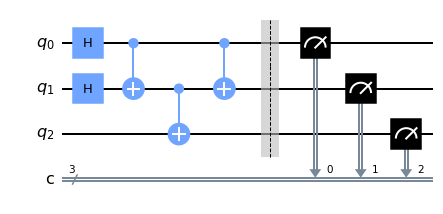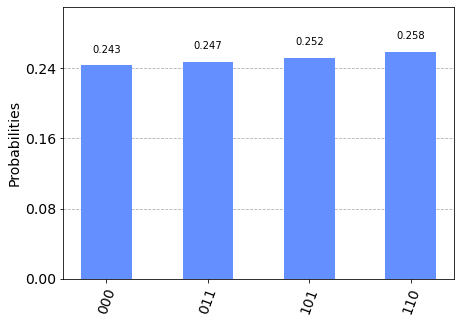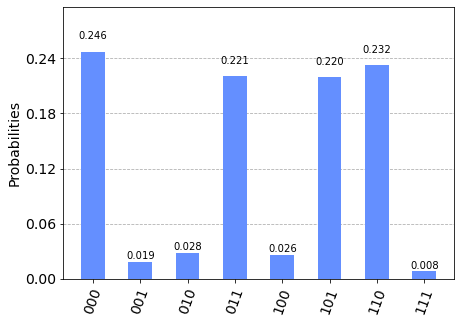A little example of quantum parallelism
Contents
8.5. A little example of quantum parallelism#
8.5.1. The Objective#
Quantum computer can calculate many different instances simultaneously. Here we consider a simple example. Suppose that we want to calculate \(z = x \oplus y\) where \(x,\, y,\, z \in \{0,1\}\). The variables are assigned to three qubits as \(|zyx\rangle = |z\rangle \otimes |y\rangle \otimes |x\rangle\). Initially, \(z=0\). The computation corresponds to transformation \(|0\rangle \otimes |y\rangle \otimes |x\rangle \Rightarrow |x \oplus y\rangle \otimes |y\rangle \otimes |x\rangle\). There are four possible instances:
We want to compute all these four cases at once.
8.5.2. Algorithm#
We use a superposition state of the four input states. First we create four possible input states with equal weight and then we compute \(x\oplus y\) for each term:
Note that the output does not include all possible states. For example \(|111\rangle\) does not exist since \(1\oplus 1 \ne 1\).
The first step can be done with the Walsh-Hadamard transformation. The addition can be done with thee CX gates as shown in Section 8.4. The following Qiskit example evaluates the four cases simultaneously.
8.5.3. Qiskit Example#
Circuit#
from qiskit import *
cr=ClassicalRegister(3,'c')
qr=QuantumRegister(3,'q')
qc=QuantumCircuit(qr,cr)
qc.h([0,1])
qc.cx(0,1)
qc.cx(1,2)
qc.cx(0,1)
qc.barrier()
qc.measure(qr,cr)
qc.draw('mpl')

Execution (noiseless)#
# Chose a general quantum simulator without noise.
# The simulator behaves as an ideal quantum computer.
backend = Aer.get_backend('qasm_simulator')
# set number of tries
nshots=8192
# execute the quantum circuit and store the outcome
job = backend.run(qc,shots=nshots)
# extract the result
result = job.result()
# count the outcome
counts = result.get_counts()
from qiskit.visualization import plot_histogram
plot_histogram(counts)

Only four states are obtained and each shows \(z = x \oplus y\). We indeed calculated four different cases at once thanks to the quantum parallelism.
Execution (noisy)#
# simulating IBL Jakarta device
from qiskit.providers.fake_provider import FakeJakarta
backend = FakeJakarta()
# set the number of tries
nshots=8192
# execute the circuit
job = backend.run(qc,shots=nshots)
# extract the result
result = job.result()
# count the outcome
counts = result.get_counts()
from qiskit.visualization import plot_histogram
plot_histogram(counts)

Notice that additional states appeared due to the noises. However, their probabilities are small and we can easily identify the four major peaks.
Last modified: 08/31/2022

